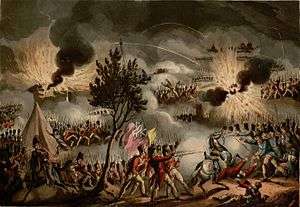Battle of Bayonne
| ||||||||||||||||||||||||||||||
The Battle of Bayonne of 14 April 1814 was a sortie by General Thouvenot's French garrison of Bayonne during the siege of that city conducted by Allied forces under Lieutenant General John Hope. The battle was the last of the Peninsular War and occurred as news of Napoleon's abdication was beginning to reach the opposing forces.
While the Siege of Bayonne was largely illusory, with French and British soldiers fraternizing and exchanging goods and letters,[2] the fighting of 14 April involved heavy hand-to-hand combat in which Lieut-Gen Hope was captured with two of his staff, 276 men and a gun, before reinforcements stabilized the Allied positions.
With Thouvenot occupying stronger positions at the conclusion of his sortie, the siege continued. On 17 April, the main French body under Marshal Soult signed an armistice with Wellington; Thouvenot would continue to resist until direct orders from Soult compelled him to observe the ceasefire.
Background
After the Battle of the Nive, Arthur Wellesley, Duke of Wellington mounted a surprise amphibious operation which crossed the Adour River estuary and isolated the French city of Bayonne. Wellington pressed east after Marshal Nicolas Soult's French army, leaving the fortress to be invested on 27 February by Hope's corps.[3]
Hope's 19,550-man force included Kenneth Howard's 1st (6,800) and Andrew Hay's 5th (2,750) British Divisions, Lord Aylmer's Independent British Brigade (1,900), Thomas Bradford (1,600) and Archibald Campbell's (2,500) Portuguese Brigades, and Carlos de España's Spanish Division (4,000). Hope's corps was joined by 10,000 Spanish troops in the divisions of Marcilla, Espeleta and Pablo Morillo, but these soldiers were sent away to join Wellington's army in time to fight at the Battle of Toulouse on 10 April.[4]
Before retreating, Soult reinforced the garrison with the division of Abbé, raising its strength to 14,000 men. The regular infantry included the 5th and 27th Light, and the 64th, 66th, 82nd, 94th, 95th, 119th and 130th Line Regiments.[4]
Battle
Hope conducted the siege in a way that was "leisurely to the point of apathy."[5] On 10 April, the same day that Wellington battled Soult at Toulouse, Hope still had not begun regular siege approaches to the city. For his part, Thouvenot remained passive during the first six weeks his garrison remained besieged.
Thouvenot received unofficial news of Napoleon's abdication on 12 April. Even though this meant that the war was virtually over, the French governor decided to attack "in a fit of spite and frustration."[6] At 3:00 am on the morning of 14 April he attacked the British siege lines with 6,000 men. The fight that followed was vicious but the French sortie was defeated with heavy losses on both sides. "Sir John Hope was wounded and captured after galloping into a melee."[6] The brunt of the battle was borne by the Anglo-German units, including the 1/1st, 3/1st, 1st Battalion Coldstream and 1/3rd Foot Guards; the 3/1st, 1/9th, 1/38th, 2/47th and 5/60th Foot; the 1st and 2nd King's German Legion (KGL) Light battalions, and 1st, 2nd, and 5th KGL Line battalions.[4]
Aftermath
The Allies lost 838 men, including Major General Andrew Hay killed and Hope captured. French casualties totaled 905 men, including 111 killed, 778 wounded and 16 missing. Despite the news of Napoleon's abdication, the defence continued obstinately until 27 April when written orders from Marshal Soult finally compelled Thouvenot to hand the fortress of Bayonne over to the British.[7]
Total losses in the siege, including the battle on 14 April, were 1,600 French killed and wounded, plus 400 captured. The Allies lost a total of 1,700 killed and wounded, and 300 captured.
Notes
References
- Castex, Jean-Claude (2013). Combats franco-anglais des Guerres du Premier Empire. Lulu. ISBN 9782921668217.
- Gates, David. The Spanish Ulcer: A History of the Peninsular War. Da Capo Press 2001. ISBN 0-306-81083-2
- Glover, Michael. The Peninsular War 1807–1814. London: Penguin, 2001. ISBN 0-14-139041-7
- Smith, Digby. The Napoleonic Wars Data Book. London: Greenhill, 1998. ISBN 1-85367-276-9
Coordinates: 43°20′00″N 1°28′00″W / 43.3333°N 1.4667°W
